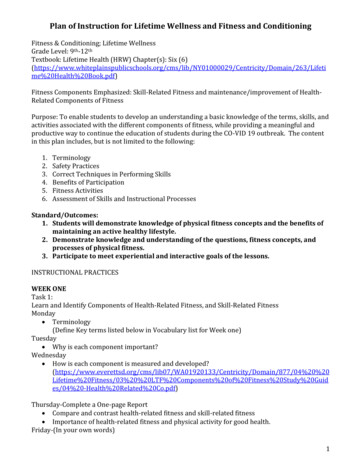
Transcription
Student Handbook5675 NORTH ORACLE ROAD, SUITE 3101TUCSON, AZ LLNESS.COMCONNECT WITH USFACEBOOK.COM/TKDWELLNESS INSTAGRAM.COM/TKDWELLNESSLAST REVISION: 6.5.2018
Table of ContentsIntroduction3Welcome Message from Dr. Yoendry Torres3Taekwondo Wellness Goal3Meaning of Taekwondo3Taekwondo Wellness Memberships4Rules & Regulations5Dojang Rules5Competition Rules5Gear Requirements5Promotion Test Requirements6Taekwondo History7Taekwondo Philosophy9The Five Tenets of Taekwondo are:9Poomsae: Forms10Kyukpa: Board Breaking14Basics of Board Breaking:14Kyorugi: Sparring15Taekwondo and Psychology17Stress Management17Grit17Growth Mindset17Deliberate Practice18Goal Setting18Positive Self Talk18Imagery18Mindfulness Meditation19Taekwondo Pedagogy/Curriculum21Taekwondo Wellness Curriculum21Taekwondo Wellness Belt Ranks & Promotion Test Requirements21Long Term Athlete Development Framework (LTAD)23Taekwondo Terminology25TKD Wellness Student Handbook 2
IntroductionWelcome Message from Dr. Yoendry TorresWelcome to Taekwondo Wellness where the goal is toteach an ancient martial art that has transformed into amodern sport and to promote healthy living throughpsychological education. By deciding to join TaekwondoWellness, you have joined millions of practitionersacross the world striving to improve themselvesphysically, mentally and spiritually through the art ofTaekwondo. The handbook will be your guide toTaekwondo rules, requirements, history and philosophy,sport psychology, and curriculum. I hope that you willfind the information within this handbook useful for yourdevelopment as a Taekwondo student and/orcompetitor.It is worth mentioning that research has shown thatmartial arts schools that focus on competition (i.e.,fighting) solely increase aggression while traditionmartial arts schools that teach its martial arts history,philosophy, meditation, self defense, sparring, as well ascompetition decrease aggression overtime in addition toaiding in stress management, helping manage weight, lowering anxiety, promoting self-esteemand confidence, improving concentration and increasing self-reliance and optimism.I look forward to teaching you what knowledge I have learned from my instructors and hopeone day that you too will continue the legacy of Taekwondo by sharing what you have learnedwith future generations. Please feel free to ask me any questions that you might have afterreading this handbook. You may also email me at: MasterTorres@TKDwellness.com. Let meknow if there is anything I can do to better your Taekwondo experience.Sincerely,Yoendry Torres, Psy.D.(AKA: Master Torres; AKA: Dr. Torres; AKA: Sir; AKA: Coach)Taekwondo Wellness GoalThe goal is to improve the mental, physical, social, and emotional health of our communitythrough teaching Taekwondo and psychological education.Meaning of TaekwondoTaekwondo comes from the three Korean words: Tae: meaning foot or striking with foot; Kwon:meaning fist or striking with hand; and Do: meaning the way or the art of. Thus Taekwondomeans the art or way of striking with the feet and hands.TKD Wellness Student Handbook 3
Taekwondo Wellness Memberships USA Taekwondo is the national governing body of Taekwondo for the United States OlympicCommittee and thus an official member of World Taekwondo. World Taekwondo is theinternational federation governing body for the sport of Taekwondo and it reports that a totalof 188 member nations are part of this federation. World Taekwondo oversees the rules ofthe sport, which include sparring, poomsae, and board breaking. Taekwondo Wellness is alocal member of USA Taekwondo that is committed to promoting healthy, active, andjoyful lives among youth, adults, and families through training in traditional Taekwondo. Kukkiwon is the World Taekwondo Headquarters for instructor education and dancertification. Kukkiwon sets black belt promotion test regulations and dan certificates arerecognized internationally & required for Olympic competition. Taekwondo Wellness blackbelts will be obtained through Kukkiwon.TKD Wellness Student Handbook 4
Rules & RegulationsDojang RulesPlease review and follow the rules for safety and to remain loyal to Taekwondo culture. It isimportant for parents to review these rules with your children to ensure proper understanding.1.Respect masters & instructors and follow their directions. Demonstrated by: Respond "Yes/No, Sir, or Ma'am" in conversation with instructors. Bow when entering and leaving the training area. Face away from the Instructor and flags when tying belt or fixing your uniform. Ask permission to enter class if student arrives late for training.2.Respect fellow students and parents. Demonstrated by: Have fun but avoid unnecessary conversation.3.Respect yourself. Demonstrated by: Maintain a clean uniform and good hygiene as it is a reflection of the student's pride. Encouraging and being kind to your self.4.Report all injuries to the Instructor.5.Students are to use martial arts skills learned in Taekwondo Wellness for protection only.Competition RulesTaekwondo Wellness is a proud member of USA Taekwondo, which means that TaekwondoWellness students will learn and are required understand and follow USA Taekwondo rules andregulations when competing at USA Taekwondo sanctioned tournaments. Competition can befun and a great way to build confidence and put to test the skills learned. The specific rules foreach can be found at worldtaekwondo.org/rules/.Gear RequirementsParents, please note that children’s uniform and gear should fit them well and not be oversizedwith excessive material, particularly the uniform pants as it creates a tripping hazard. Gear anduniforms can be purchased at TKDwellness.com/gear. The following are the gear requirementsfor Taekwondo Wellness students by rank: White Belt: Beginning students are not required to purchase a uniform if taking classesjust for fun or for fitness; however, if student decides they want to promote up theTaekwondo ranks then a white v-neck uniform is required. Green Belt: Green belt students will continue to use a white v-neck uniform. Sparringgear requirements include: Head protector, foot/shin protector, hand protector, Trunkprotector, cup, and mouth guard are required beginning at green belt, which is whensparring training begins.TKD Wellness Student Handbook 5
Red Belt & Above: Students who are red belts and above require a black v-neckuniform and will continue to use same sparring gear as purchased as a green belt. Competition & Demo Team: Yellow belts students and above will have the option ofjoining the competition & demo team. Students who choose to be part of thecompetition & demo team will be required to sign a team agreement and obtain andmaintain an annual USA Taekwondo athlete membership as well as attend specialevents throughout the year to showcase their skills at public demonstrations. Inaddition, team members will get extra conditioning and training seminars to preparethem for competitions and demonstrations. Students who choose to compete in USATaekwondo tournaments will also be required to purchase sanctioned equipment thatincludes sparring gear for sparring athletes and a competition uniform for poomsaeathletes. A listing of World Taekwondo recognized brands can be found: zed/Promotion Test RequirementsAs the saying goes, “A black belt is a white belt that never gave up.” It is important to know thatit takes a lot of dedication, sweat, and passion for personal development in order to promoteup the Taekwondo ranks. The focus of training should not be only to obtain a black belt insteadthe focus should be on the daily steps taken on your journey towards growth, excellence andpersonal improvement.Promotion tests are by invitation only but all students and their friends and family members areinvited to come support students who are testing. The instructor will inform students once theyhave demonstrated proficiency of belt level requirements and earned their belt strips. The beltstrips are monthly tests of proficiency for 1) basic knowledge, 2) Poomsae, 3) One Step &Board Breaking and 4) Sparring.Promotion tests at Taekwondo Wellness are offered every quarter of every year in March,June, September and December. Students are typically ready to promote after 3 months oftraining twice weekly. Once a student has been invited to promote, they are required tocomplete promotion test form prior to test. Students are encouraged to invite their friends andfamily to come watch them test and demonstrate what they have learned.TKD Wellness Student Handbook 6
Taekwondo HistoryMuch to my surprise, the history of Taekwondo is actually a controversial topic with officialsfrom Kukkiwon and many others stating that Taekwondo dates back to the Three Kingdomsperiod (discussed below) while others argue that Taekwondo was first derived from Japanesekarate around the time of the Korea liberation from Japanese colonial rule. To be honest, I amnot a historian nor do I claim to be an expert on this topic. So to be fair, I will offer both pointsof view to the best of my ability.According to Kukkiwon, “Korean martial arts faded into obscurity during the late GojoseonDynasty, the first state on the Korean peninsula, B.C. 2333 and developed during the ThreeKingdoms period.” The three kingdoms period consisted of:1. Silla Kingdom: Silla, which was founded on the Kyongju plain in 57 B.C., was credited withspreading marital arts throughout Korea. During this kingdom, martial arts was mainly usedas a sport and recreational activity.2. Koguryo Kingdom: Koguryo, which was founded in the Yalu River Valley in 37 B.C, is thebirthplace of martial arts and Tae Kyon is considered the earliest known form of Taekwondo.3. Paekche Kingdom: Paekche, which was founded in the southwestern area of the Koreanpeninsula in 18 B.C., favored barehanded fighting as a fighting art.Hwarang-Do warriors were martial arts trained warriors who became known for their braveryand fighting skill. Also, they soon supplied the leadership to defeat both the Paekje andKoguryo kingdoms and unify Korea into one country known as the Koryo kingdom. The guidingprinciples of these warriors were loyalty, filial duty, valor, and justice. The Warriors educationwas based on the 6 codes of conduct:1. Loyalty to your country4. Respect your teachers2. Faithfulness to your spouse5. Indominable spirit3. Respect your brothers and sisters6. Finish what you beginThe Koryo Dynasty (918 AD to 1392) was a time for growth and development for martial arts.During this kingdom, unarmed combat gained great popularity and Tae Kyon involved as newkicking techniques developed and was designed as a fighting sport than a discipline. Thesoldiers learned and practiced these forms of martial arts, and throughout their travelsthroughout different kingdoms they spread the study of these martial arts.The Yi Dynasty (1392 AD to 1910) experienced a change from following Buddhism toConfucianism. This change brought about a change to martial arts as people began to loseinterest over martial arts. In fact, the study of martial arts, including weapons, was bannedexcept for the militaryAfter the Yi Dynasty, Japanese took control of Korea and during Japanese control, only themilitary could practice martial arts. Japanese combat techniques was introduced to Korea atthis time and it became popular. Moreover, due to the peace treaties between Japan andTKD Wellness Student Handbook 7
Korea, Japanese education and martial arts were introduced into Korean schools. Once again,martial arts began to flourish in Korea and Japan and Korea began to exchange combattechniques. In 1945, Korea was freed and Korea could now practice its form of martial arts.During the 1960s after Korea got independence from Japanese control, modern Taekwondowas born, influenced by Japanese Karate at the very least. Dojangs appeared, such as ChungDo Kwan, Songmuguan, Mudukguan, Joseon Yeonmuguan kwonbubbu. Moreover, the KoreaTaesudo Association (the name was later changed to Korean Taekwondo Association) wasfounded on September 16th, 1961.During the 1970s, Kukkiwon was founded as the KTA central dojang on November 30th, 1972.Kukkiwon devotes itself to spread Taekwondo culture, spirit and history worldwide, increasingthe best competitive power of Taekwondo as a martial art in life. Kukkison preservesTaekwondo's roots and development, controls Dan testing and Dan testing requirements, andpromotes the study of Taekwondo all over the world.In 1973 the World Taekwondo Federation was officially established at the Kukkiwon. During the1980s, Taekwondo started becoming popular in universities as a major or a study. Taekwondolater became a demonstration sport in 1988 during the 24th Seoul Olympics and then becamean official Olympic sport at the 103th IOC Assembly in Paris, France. At the same time, theKorean language became the official language for the olympic Taekwondo games. Taekwondomade it first Olympic appearance during the Sydney 2000 Olympics. According to WorldTaekwondo, as of 2017 the global membership for World Taekwondo stands at 209 membernations across five continents.TKD Wellness Student Handbook 8
Taekwondo PhilosophyThe philosophy of Taekwondo represent the principles of changes and movements in humanbeings. It can be explained in several ways but here we will explain it simply with the principleof “Sam Jae” (three elements) and that of “Eum” (Negative or Darkness) and “Yang” (thepositive and the brightness). “Sam Jae” refers to “Cheon” (the heaven), “Ji” (earth), and“In” (the man). In oriental countries, the philosophical principles of Taekwondo are recognizedas the central principle that explains changes of everything in the world.The Five Tenets of Taekwondo are:1. Courtesy (Ye Eui): Courtesy is behavior that demonstrates consideration, cooperation,respect, and generosity towards others and towards oneself. Examples: Bowing at beginning/end of class; Saying thank you; Doing chores;Greeting parents/teachers; Positive self-talk; Maintaining good/positive physical/mentalhygiene.2. Integrity (Yom Chi): Integrity is being able to define right from wrong, stand incorruptibleand have the conscience, if wrong to feel guilt and apologize. Integrity also applies to beinghonest with ourselves. Examples: Never cheating; Not lying; Never stealing; Avoiding self-deception;Admitting to self when upset; Admitting wrong/mistake; Apologizing.3. Perseverance (In Nae): Perseverance is the ability to persist in pursuing something in spiteof obstacles or opposition and to have the patience to do so. Moreover, havingperseverance is having a belief that traits can be developed with effort and hard work(growth mindset) and grit (passion perseverance grit). Examples: Never giving up on your passion; Persisting through difficulties; Continuingtraining even if you are tired; Refusing to quite even when there are difficulties/obstacles.4. Self-Control (Geuk Gi): Self-control is the ability to control our responses to our emotionsas well as having control of body. Self-control is also exercising restraint over one’simpulses, also known as self-discipline. Examples: Thinking before acting; Not hitting others or self out of anger or frustration;Maintaining focus during meditation; Performing techniques with proper execution andaccuracy; Practicing poomsae with coordination, balance, power, speed, etc.5. Indominable Spirit (Baekjul Boolgool): Indominable spirit, commonly referred to ascourage, describes a spirit incapable of being subdued or overcome and is associated withbeing modest and honest. It persists in spite of fear and hesitation to demonstrate courage. Examples: Telling parents about problems; Seeking help; Telling someone how youtruly feel; Competing in a tournament; Saying no to friends; Acting with integrity whenothers do not or when no one is looking.TKD Wellness Student Handbook 9
Poomsae: FormsPoomsae is an integral part of almost every martial art as it was the way the art/style itself waspassed down from one generation to the next. Poomsae includes great theory of offense anddefense mentally and physically and unifies the essentials of the sprit and technique of theTaekwondo. The overall purpose of poomsae is to control the breathing to be synchronizedwith actions, and to maintain the center of gravity and balance while executing techniquesrequiring great speed.In order to standardize the practice of forms in Taekwondo, World Taekwondo developed a setof forms called the Taekgeuk Poomsae. When these forms were being created, all of thesemovements, techniques, and projected meanings were based on the 8 Trigrams, with eachone of the Taegeuks representing a different Trigram.To practice the Taegeuk forms properlyand to convey their intended meaning, it is necessary to combine both the physical and mentalaspects of the Taegeuk forms.When practicing poomsae, strive for:Stance: Elegance and stable line, pattern of poomseGaze: Offense and defense direction of movementsBalance: Maintaining good connection of each movementVelocity: Control for speed of all movementsIntensity: Control for strength of all movementsDirection: Memorized for pattern of engagementBreath: Internal and external energyExpression: Mentally, physically, emotionallyTaegeuk, the spirit of Taekwondo, is derived from the words “Tae” meaning largeness and“geuk” meaning eternity. Moreover, the idealisms of Taegeuk are: Pacifism, Unity, Creativespirit, Future spirit and Eternity.Taegeuk poomse follows different theories and implements them into methods of attack,defense, forward movement and retreat, control of the speed of the movements, and theintensity of the actions. A couple theories include the Yin Yang theory, the destructive theory,the great absolute theory, and the Ohaeng theory. The destructive theory claims that fire meltsfire, metal cuts wood, and the earth blocks water. The “Yin Yang theory” (the law of nature)describes the negative and the positive, and the male and female. Another theory claims thatthe elements of metal, water, wood, fire, and earth are believed to help each other to beproduced; fire from wood, wood from water, water from metal, metal from earth, and earth fromfire.Palgwe represents the heaven and sky, water (lake, marsh etc.), fire, sun, light, thunder, wind,wood, water (springs, streams), mountains and hills, and the earth. It also represents the eightcardinal and the intercardinal directions (North, South, East, West, Northeast, etc.). The 8TKD Wellness Student Handbook 10
symbols of “Gwe”, originating from Taegeuk/created from the male and female which is theroot of all creation, represents the direction and lines of movement.The other “Gwe” werecreated from other direct creations of Taegeuk. The 8 symbols of “Gwe” (Palgwe): Keon, Tae,Ri, Ji, Seon, Gam, Gan and Gon.PoomsaePalgwe (Gwe)MeaningDefinitionTaegeuk 1:Il Jang (18)Keon“Heaven”Keon is the powerful, the mother of all, the pure Yang, the father,and the initial molding force that guides the future actins andoutcomes in forms.Taegeuk 2:Yi Jang (18)Tae“Lake”Tae is the state of mind (serene and gentle yet firm). Themovements mainly show that even though there are boundariesthat control our actions, we can overcome them.Taegeuk 3:Sam Jang(20)Ri“Fire”Ri is meaning of warmth, enthusiasm, and hope. Since fire isimportant for survival but can cause catastrophes, the techniquesof this form should be done in a rhythmic way with occasionaloutbursts of energy.Taegeuk 4:Sa Jang (20)Ji“Thunder”Jin means fear and suggest we should act calmly and with couragewhen facing danger. Since thunder reaches down to the earth in ahurry and seeks the shortest route when reaching the highestpoint, this form should be performed by seeking the shortest pathto the desired goal but not losing the ability to react to surroundinginfluences.Taegeuk 5:Oh Jang(20)Seon“Wind”Seon can be as gentle as a breeze and as destructive as a ragingstorm. Since the wind (predominantly Yang) can be both gentle anddestructive, this form should be performed with elegance whilecontaining the ability to cause mass destruction with a singlemovement.Taegeuk 6:Yook Jang(23)Gam“Water”Without it, nothing can survive. As with water, we can overcome alldifficulties with confidence and persistence. We can bend, but notbreak, flowing continuously. This form should be performed inaccordance with the dual nature of water.Taegeuk 7:Chil Jang(25)GanTaegeuk 8:Pal Jang(24)Gon“Mountain” The mountain show us when to proceed and when to rest. It showsthat it is important to eliminate wasted energy and motion. Since allmountains (predominantly Yin) share the same grandeur andmajesty despite the physical dimensions , this form should beperformed with the feeling that your movements should receivehighest praise and esteem.“Earth”Life exists because of the earth and the earth nourishes andeassures us with the patience of the mother. This is the completionof one cycle and the higher forms. Gon is pure Yin ( the end of thebeginning, the dark side, the evil element of all that is good), buteven in a state of complete darkness there is still light to be foundand should be performed keeping this in mind.TKD Wellness Student Handbook 11
Black Belt PoomsaeDefinitionKoryo (Korea) -30 movesPoomsae Koryo, a name of an ancient dynasty (AD 918-1392) inKorea, is one’s posture of cultivating himself in which he may followthe wisdom and unyielding spirit of the man of conviction.1st Dan PoomsaeKeumgang (Diamond) – 27moves2nd Dan PoomsaeTaebaek (Mountains) – 26moves3rd Dan PoomsaePyongwon (Plain) – 25moves4th Dan PoomsaeSip Jin (Decimal) – 39moves5th Dan PoomsaeJitae (Earth) – 37 moves6th Dan PoomsaeSince the most beautiful mountain in the Korean peninsula isnamed Keumgang-san and the diamond (the hardest knowsubstance) is named Kuemgange-seok, Keumgang in Taekwondomeans movement based on spiritual strength that is as beautiful asthe mountains (has a sharp and majestic spirit) and as hard as thediamond.Since Mount Baekdoo is the loftiest and grandest mountain inKorea, and the word “Taebaek” has the meaning of light and isbeing looked upon as sacred by the Korean people, every motionof this poomse should be in accordance with these principles.Since the plains give us food but at the same time gave us afeeling of majesty, the core of this poomsae is to be found in thepotential strength and flexibility as well as in the majestic spirit ofthe vast plain.Sip Jin, a master form; largest form, represents the “Sipjangsaeng”,the longest living things (the sun, mountains, water ) and is basedon nature worship, and the decimal system that makes eternalnumbers. It has various changes (slow action and moderation arenecessary). It is also important to devote the power slowly withinthe 1st, 3rd, 9th, 23rd, and the 27th movements. When executinghorizontal Twin Side Punch (Chetdari Jireugi), practice carefullybecause it consists of two kinds of stances, the Forward Stance(Apkubi) and the Back Stance (Dwit Kubi) Sipjin Poomse consistsof 31 Poom and 39 movements.Since the Jitae (earth) is the place to find peace for all life, itsymbolizes desire and the coming out of the earth.The use ofhands and blocking is emphasized in this Poomse. Devote powerslowly within the 2nd, 4th,8th, and the 10th movements. The Diamondshape Front Punch (Geumgang Apjireugi) blocks strikes to theface, and simultaneously delivers a punch. The 21st movementrequires a long period of time and practice to learn. Execute theSide Kick (Yeop Chagi) so that the foot lands in it original position,and at the same time execute the Wrist Low Section Block (PalmokArea Makki) then assume the Crane Stance (Hakdari Seogi).Maintain even balance of power. There are 28 Poom and 37movementsTKD Wellness Student Handbook 12
Cheongwon (Sky) -38moves7th Dan PoomsaeHansoo (Water) – 33 moves8th Dan PoomsaeIIyo (Oneness) -29 moves9th Dan PoomsaeCheongwon symbolizes the meaning of the sky (is the origin of alllife) and slow action and moderation are important for this Poomse.New movements include: The Spread Off Wing (has theappearance of an eagle flying through the air). The Double KnuckleFist Spring Strike (Bamjumeok Soseum Chigi). The Push MountainShape (Taesan MIlgi). Devote the power slowly within the 5th, 7th,24th, 25th, 26th, and 27th movements when executing the SidePunch (Yeop Jireugi) while pulling the opponent after executing theHugh Section Block (Eolgul Makki) 23rd movement. A high jumpmust be made prior to the 360-degree turn to the left, then theRight Target Kick, and the Diamond Shape Side Punch may beexecuted. Consists of 23 Poom, and 38 movementsHansoo represents water (creates life and allows growth, may bestronger and more dangerous, is extremely adaptable, formlessand flexible). New movement includes: The Arc Hand Neck Strike(Akeumson Mok Chigi). There are 23 Poom and 33 movementsMeans that the mind (spirit) and body (material) are the same.Follows the philosophy that mind and body are as one. Thisphilosophy is emphasized within the 3rd, 9th, 10th, 14th, 16th, 17th,20th, and 21st movements. Iilyo Poomse consists of 23 Poom and29 movements. When Side Kick (Yeop Chagi) within the 19th and23rd movements, flex the balance leg toward the kicking legTKD Wellness Student Handbook 13
Kyukpa: Board BreakingTaekwondo is known for its demonstration of power through board breaking. At TaekwondoWellness, board breaking is practiced as a measure of a student’s power, accuracy, focus,courage, technique and speed. Board breaking is also a requirement for rank promotion tests(see Taekwondo Pedagogy/Curriculum for specific board breaking requirements by rank). It isimportant to remember that students are breaking real wooden (usually pine) boards, whichcan cause bruising, swelling, or even cuts/bleeding. Regardless of that fact, many studentsfind board breaking fun and exhilarating and a source of great pride.Board breaking is also a competitive sport called “creative breaking competition.” Students ofall ranks can register for creative breaking divisions at USA Taekwondo sanctionedtournaments. For USA Taekwondo creative breaking competition guidelines, please nts/Competition-Rules. Additionally, TKDWellness’ competition and demo team members will get additional practice breaking boardswith advanced techniques and performing them during live demonstrations.Basics of Board Breaking:1. Learn the proper technique. Then drill, drill, drill to master it.2. Perform strengthening and speed exercises to build appropriate muscles and conditioning.3. Practice techniques on heavy bag, other conditioning equipment, to build strength, timingand accuracy.4. Aim for the center of the board and plan on going through the board rather then stopping atthe front of the board in order to easily demolish boards.5. Ki-hap simultaneously as you strike the board and tense your muscles at impact.6. Practice techniques on re-breakable boards starting with the easiest one first.7. Remember to be confident in your technique after putting in all that hard work and effort.TKD Wellness Student Handbook 14
Kyorugi: SparringThere are several styles of sparring in Taekwondo from one-step (or two or three or instinct)sparring, to no contact or light contact free sparring, to competition sparring using appropriategear, to full contact. At Taekwondo Wellness, one-step sparring and no contact or light contactsparring using necessary gear is required for promotion tests. For students interested incompetition, sparring typically consists of light to moderate contact using all appropriate gear,following USAT competition rules and with the focus of scoring points without getting scoredon. For complete USA Taekwondo sparring competition rules, please visit: mpetition-Rules. Below are a few basicsparring rules taken directly from their manual:1. Competitors must wear white v-neck uniform in good condition.2. Competitors must wear approved protective gear including trunk protector, head protector,groin guard, gloves, forearm protectors, shin/in-step protectors and mouth guard. Onecompetitor wears red trunk protector (Hong) and the other blue trunk protector (Chung).3. Contestants are not allowed to wear any kind of metallic articles or hard objects, such asrings or eyeglasses necklaces, watches, bracelets, earrings, etc.4. All competitors must maintain the highest standard of personal hygiene, keep their nails cutshort, and groom their hair neatly. Pony tails must be tucked inside the headgear5. Permitted techniques include straight punches using knock part of a tightly clenched fist andfoot techniques using any part of the foot below the ankle bone.6. Punches and kicking techniques are permitted on the areas covered by the trunk protectorbut not on the part of the spine. Only kicking techniques are permitted to the head.7. The valid points are as follows:1. One (1) point for a valid punch to trunk protector2. Two (2) points for a valid kick to the trunk protector3. Three (3) points for a valid turning kick to the trunk protector4. Three (3) points for a valid kick to the head5. Four (4) points for a valid turning kick to the head6. One(1) point awarded for every Gam-jeom (penalty shall be counted as one (1)additional point for the opposing contestant)8. Prohibited acts: The following acts shall be classified as prohibited acts, and “Gam-jeom”shall be declared:1. Crossing the Boundary Line2. Falling down3. Avoiding or delaying the matchTKD Wellness Student Handbook 15
4. Grabbing or pushing the opponent5. Lifting the leg to block or/and kicking the opponent’s leg to impede the opponent’skicking attack, or lifting a leg or kicking in the air f
Jun 05, 2018 · USA Taekwondo is the national governing body of Taekwondo for the United States Olympic Committee and thus an official member of World Taekwondo. World Taekwondo is the international federation governing body for the sport of Taekwondo and it reports that a










